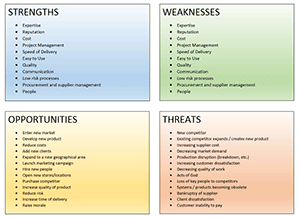
In today’s ultra-competitive business environment, strategic planning is more than ever a necessary tool to growing a successful business. Even large companies are not immune to sharp downturns and failed strategic plans.
Strategic planning is a process that results in the development of a strategic plan (really!). The strategic planning model in use by businesses and colleges today is not well defined (compared to, say structural engineering, which is my background) but it contains the following basic features:
- Corporate Vision
- Mission Statement
- SWOT Analysis
- Corporate Goals
- Strategies
- Key Performance Indicators
- Industry Analysis
Corporate Vision
The corporate vision statement is a sentence describing the desired state that the organization wants to achieve in the long term. It is a high level goal, stated in broad terms. It relates to a 5 – 10 year time frame. Because it is high level and very general, it is usually hard to measure directly and everyone relates to it in their own way. But it provides the highest level direction for the organization.
Examples of corporate vision statements:
- To continuously meet or exceed the customer’s expectations.
- To become one of the world’s premier companies in our industry.
- To be the preferred provider of solutions for our customers.
Mission Statement
A slightly lower level, but still broad, statement of purpose is the mission statement of an organization. It consists of a statement of purpose of the organization, stated from a customer perspective. Although still a broad, high level statement, it can be combined with the vision statement.
Examples of mission statements:
- To become the best value supplier.
- To fill the demands of our customers quickly, accurately, and economically.
- To dominate the markets we compete in.
 SWOT Analysis
SWOT Analysis
A SWOT analysis is a wonderful tool. The acronym stands for Strengths-Weaknesses-Opportunities-Threats. A proper analysis of each of these areas of your business is a necessity in order to provide a complete strategic plan. It helps you decide where best to focus your efforts for maximum impact.
I also love it because it’s one of those big picture analysis tools. Sometimes people, especially the practitioners of a process, can get lost in the numbers and the analysis, whereas I, the manager/owner, am more interested in the big picture that it provides.
Corporate Goals
Goals are an aim to which the organization channels efforts that contribute to its achievement. Although still very high level, they must be measurable. They should be limited to several most crucial areas for the business. They offer a “path” to reach the Vision and should consist of a 3 – 5 year time frame.
Examples of corporate goals:
- Grow revenue by 20%/year.
- Become the lowest cost supplier.
- Reduce costs by 10%.
Strategies
Corporate Strategy are the means by which a corporate goal is achieved. Strategies are high level and organization-wide. They utilize business financial metrics and can be directed specifically toward functional areas.
Examples of strategies:
- Continuously reduce production costs
- Improve supply chain management
Key Performance Indicators
No strategic plan is complete without Key Performance Indicators (KPI). KPI’s provide the basis for measurement of the success of the plan. As an owner-manager as well as shareholder in several companies, I’ve always found it interesting how investors and management look at the business from different angles. Investors want to see certain numbers such as earnings per share, cleanly filtered through the accounting department (and audited). Management, on the other hand, want to see the basic, raw data (at least I do!). Things like:
- How many widgets did we sell in the period?
- How many new clients did we get?
Things like that tell you how the business is really doing and produce the data from which decisions can be made. These are the Key Performance Indicators, and all management staff should know what they are at any given time. If you don’t have an established set of KPI’s for your job or business unit, maybe it’s time to start.
Key Performance Indicators can be used to develop and manage key improvement projects.
Industry Analysis
The strategic plan isn’t complete without a minor industry analysis, although a full market analysis research report is probably outside the scope of strategic planning. Every business owner, manager, or entrpreneur should have an idea of:
- Whether the market is growing, shrinking, or staying the same.
- Who the competitors are, and their strengths and weaknesses. At least have a general idea of the competitiveness landscape.
- What the industry trends are.
Good luck with your strategic planning!






